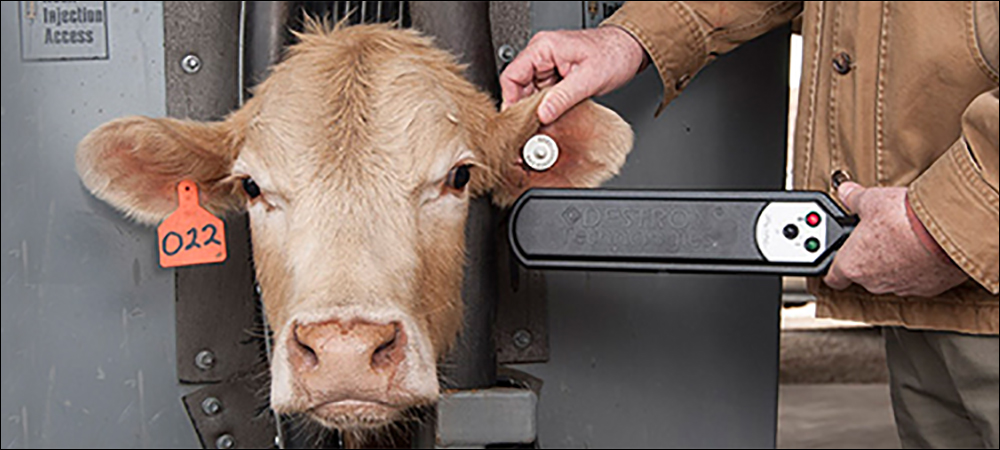The The U.S. Department of Agriculture (USDA)’s Animal and Plant Health Inspection Service (APHIS) is proposing to amend animal disease traceability regulations that require electronic identification for the interstate movement of many cattle and bison. The rule already requires official ear tags to be visually and electronically readable for official use during such animals’ movement.
The suggested revisions are aimed at clarifying record requirements related to cattle, including requiring official identification device distribution records to be entered into a tribal, state or federal database, which would then be made available to APHIS upon request. Some RFID tags, attached to the cattle by producers, are already being read as the animals cross state lines.
The Animal Disease Traceability section of 9 CFR (Code of Federal Regulations) Part 86 dictates that an official ID must be listed on documentation for the interstate movement of cattle and bison whose classes are not exempt. APHIS has been working toward the recommended changes to the official ID requirements for specific classes of such animals since 2019, according to William Wepsala, APHIS’s public affairs specialist. It is now pursuing the current proposed rule process to obtain comments from stakeholders for consideration, prior to updating the requirements.
Electronic Identification Tag Benefits
The U.S. cattle and bison herd fluctuates between 85 million and 100 million animals annually, the USDA reports, including some bison and cattle that move between states but are exempt from official ID requirements. Electronic identification (EID) ear tags provide benefits to the those in the cattle industry, the organization contends. For one thing, animals with non-EID ear tags must be physically restrained to enable their tag’s ID number to be safely read and transcribed.

William Wepsala
Visual ear tag numbers often need to be recorded on paper, or they must be manually entered into a database. Ear tags must often be cleaned before their numbers can be accurately read. At times, errors can occur during the reading or transcribing stages, or as the non-electronic tag numbers are entered into a database. That means producers may pay the cost of the time required to restrain the animals, reading the numbers or correcting errors.
Currently, the only approved electronically readable official ID tags are RFID tags. The proposed rule change, Wepsala says, would affect any class of cattle or bison that currently requires official IDs for interstate movement. Under existing regulations, all sexually intact cattle and bison 18 months of age or older are subject to the official ID requirements. In addition, all female dairy cattle of any age and all dairy males born after March 11, 2013, must be electronically identifiable, as must all cattle and bison of any age used for rodeo or recreational events, as well as cattle and bison of any age used for shows or exhibitions.
“At some future time,” Wepsala says, “there may be other electronically readable technology.” He adds, “APHIS’s goal is to rapidly and accurately collect the tag numbers and be able to adapt to technological developments, not to codify RFID technology as the only technology option for traceability.” Thus far, approved devices include 134.2 kHz LF RFID tags compliant with both the 11784 and 11785 ISO standards, or UHF RFID tags, which were more recently introduced to the market.
Reading Tags Throughout an Animal’s Life
APHIS has provided official ID tags for many years. Beginning in 2020, it provided up to eight million LF RFID button tags each year for state animal health officials for use in monitoring cattle and bison in their states. APHIS does not recommend specific tag providers, but tag companies may submit specific products—encoded with a 15-digit official ID number beginning with “840,” the ISO country code for the United States—to APHIS for approval. The agency maintains a list of approved tag providers.

Rod Saunders
The Animal Disease Traceability section of 9 CFR Part 86 dictates that an official ID number must be listed on all documentation for interstate movement of non-exempt classes of cattle and bison. However, as animals cross state lines with RFID tags, reading those tags automatically confirms their origins, age and weight, as well as their health and vaccination or antibiotic history, and the system updates that data digitally.
Where and how RFID cattle tags are read varies depending on the production practices, the way producers sell their animals, and how they maintain their records, Wepsala explains. In some cases, he says, cattle producers read tags as part of their own records-management and production practices, or they may choose to do so only for official ID purposes.
Additionally, APHIS reports, veterinarians have begun using RFID in some scenarios. Typically, accredited veterinarians are employed by private veterinary businesses or private practices, and they do not work for the USDA. Some, however, use the collected RFID data to upload and track animal health information.
UHF’s Read Range Offers Greater Visibility
While LF RFID tags are predominant for livestock management, a transition is now underway that includes UHF technology, according to Rod Saunders, Convergence Systems Ltd. (CSL)’s business development manager for Americas, which offers a longer read range, among other attributes. For example, Utah technology company Fort Supply Technologies offers a variety of cattle-management solutions using UHF RFID tags. The Fast Herd and Value Tracker software solutions store data regarding cattle’s movements and status, while Asset Tracker readers, in the form of fixed or handheld devices, capture individual animal identification at a range of 15 to 25 feet, says Nephi Harvey, Fort Supply’s CTO.

Nephi Harvey
Some companies are using the system to identify every animal at specific points throughout their life, such as when they are weighed prior to slaughter. The Fast Herd system can automatically read UHF RFID tags attached to cows’ ears, with antennas mounted above a weight scale. The system then automatically captures each animal’s ID and weight. The technology is also being used to confirm that animals have not recently received any kind of injectable antibiotic or vaccination before arriving. If the system identifies that they have been treated with such medications, they can automatically be assigned an “uncleared” status, with users alerted to remove them from the pen.
In addition, Fort Supply’s UHF RFID solution is being used for border crossings between states, as well as from Mexico into the United States. In the past year, the company conducted a pilot that involved reading the tags of 420 cattle entering the country from Mexico into El Paso. As the animals were run through chutes on their way to the border, they passed UHF RFID reader antennas mounted by Fort Supply, each of which was identified even with large numbers of cattle moving relatively fast. The tags were read as the animals walked onto scales as well.
To confirm that no tags were missed, a handheld UHF RFID reader and an Android device with Bluetooth connection also captured tag reads, then forwarded the data to the cloud, where the Fast Herd software reconciled the information. In this way, the cattle were counted at high speed, replacing what has historically been a manual process. Counting cattle, Harvey says, can be “one of the hardest things to do in the world,” due to the unpredictable milling and movement of large numbers of cattle. RFID tag reads could be captured as animals from Mexico were inspected by American USDA veterinarians before the cattle crossed the border.
Hands-Off Cattle Traceability
These days, cattle coming over the border often have four or more tags attached to their ears for a variety of purposes, including a metal tag required by the USDA that certifies each cow has been tested for tuberculosis. In the future, such data could potentially be stored digitally, along with the RFID tag data. Approximately 1.2 million cattle cross the border into the United States every year, and they may continue on to cross state borders as well. Many cattle entering the U.S. from Mexico, for instance, cross from New Mexico into Texas, at which point the State of Texas requires a veterinary certification.
“What we demonstrated with the software is that we can provide hands-off traceability across all those stages,” Harvey states, “and show on a map where the animals have been and where they’re going.” Customers of such full traceability systems, he notes, include the feed lot, the private company managing the animal crossing at the border, and state governments and packing plants. Businesses around the United States are now using different iterations or pieces of that solution, while UHF standards are under review for livestock use.
The USDA defined an interim standard in 2016 that is intended to achieve uniformity in how animal numbers are encoded into UHF tags, and the APHIS-approved tag must have an 840 as the first three numbers of the animal identifier. The agency is currently receiving comments for its modification to the electronic tag mandate. At the end of the comment period, APHIS plans to review all comments received, after which a decision will be made as to what final rule changes will be applied, if any. A summary of the comments received, along with APHIS’s responses, will be included in the “Final Rule preamble.” The review process does not have a set timeline, APHIS reports.
Key Takeaways:
- The USDA’s APHIS division is inviting comments to its new animal disease traceability scheme, which involves electronic tags in the form of LF or UHF RFID tags.
- A growing number of UHF technology providers, such as Fort Supply, are selling solutions for companies managing cattle from birth to slaughter, including as they move across state borders or the U.S. border from Mexico.



